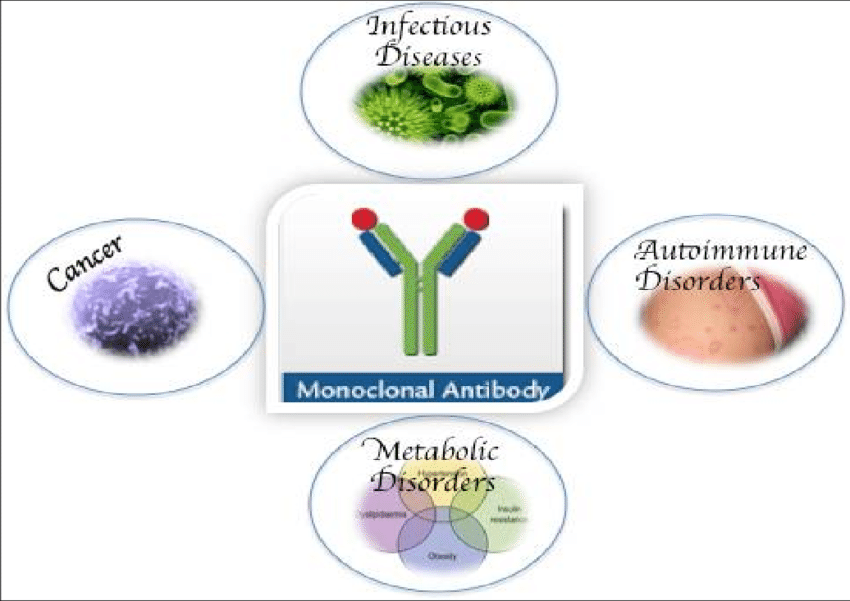Introduction
Monoclonal antibodies (mAbs) have revolutionized modern medicine by providing highly targeted therapies for a wide range of diseases, including cancer, autoimmune disorders, and infectious diseases. Their ability to precisely target specific cells or proteins has led to more effective treatments with fewer side effects than traditional therapies. With the growing number of approved mAbs and ongoing research, their role in healthcare continues to expand, offering hope for conditions that were previously difficult to treat.
What Are Monoclonal Antibodies?
Monoclonal antibodies are laboratory-made molecules that mimic the immune system’s ability to fight off harmful pathogens such as viruses and bacteria. These antibodies are designed to bind to specific antigens (proteins found on the surface of cells), allowing them to precisely target disease-causing cells without affecting healthy tissues. The precision of mAbs has made them a game-changer in the treatment of various diseases.
Types of Monoclonal Antibodies
Monoclonal antibodies are categorized based on how they are produced and their mechanism of action:
- Murine mAbs: Derived from mouse cells, these were the first monoclonal antibodies developed, but they often triggered immune responses in humans.
- Chimeric mAbs: These are part mouse and part human, reducing the risk of immune reactions.
- Humanized mAbs: These are mostly human, with only a small portion of the antibody derived from mouse proteins.
- Fully Human mAbs: As the name suggests, these are entirely human-derived, minimizing the chance of immune rejection.
Applications of Monoclonal Antibodies
- Cancer Treatment: Monoclonal antibodies have been a breakthrough in oncology, particularly in targeted cancer therapies. For example, some mAbs can bind to specific proteins on cancer cells, marking them for destruction by the immune system or delivering toxic substances directly to the cancer cell to kill it. Examples include:
- Rituximab: Used in the treatment of certain types of lymphoma and leukemia.
- Trastuzumab (Herceptin): Used for HER2-positive breast cancer by targeting the HER2 protein on the surface of cancer cells.
- Autoimmune Diseases: Monoclonal antibodies have also transformed the treatment of autoimmune diseases such as rheumatoid arthritis, psoriasis, and Crohn’s disease. By targeting specific immune system pathways, these treatments help to reduce inflammation and slow disease progression.
- Adalimumab (Humira): Used to treat rheumatoid arthritis by targeting tumor necrosis factor-alpha (TNF-α), a molecule involved in inflammation.
- Infectious Diseases: mAbs are increasingly being used to combat viral infections. During the COVID-19 pandemic, monoclonal antibodies played a vital role in treating patients at high risk of severe illness.
- Casirivimab and Imdevimab: These mAbs were developed to target the spike protein of the SARS-CoV-2 virus, helping prevent the virus from entering human cells.
- Chronic Diseases: Diseases such as asthma and high cholesterol have also benefitted from monoclonal antibody therapies. For example, mAbs can target specific immune cells involved in inflammation or proteins that regulate cholesterol levels.
- Dupilumab: Used to treat asthma by inhibiting the IL-4 and IL-13 signaling pathways, which are involved in inflammation.
Benefits of Monoclonal Antibodies
- Targeted Treatment: mAbs are designed to target specific cells or proteins involved in disease, making them more effective and reducing damage to healthy cells.
- Reduced Side Effects: Because of their specificity, monoclonal antibodies often result in fewer side effects compared to traditional treatments like chemotherapy.
- Versatility: Monoclonal antibodies can be engineered to treat a wide range of diseases, from cancer to chronic inflammatory conditions and infectious diseases.
Challenges of Monoclonal Antibodies
Despite their many advantages, monoclonal antibodies face several challenges:
- High Costs: Monoclonal antibodies are expensive to produce and administer, making them inaccessible to some patients.
- Risk of Immune Reactions: Although newer generations of mAbs are less likely to trigger immune responses, there is still a risk, particularly with non-humanized antibodies.
- Complex Manufacturing: The production process of mAbs is complex and requires significant time and resources, leading to high costs and potential shortages.
The Future of Monoclonal Antibody Therapies
The future of monoclonal antibodies looks bright, with ongoing research focused on improving their efficacy, reducing costs, and expanding their applications. One area of research involves bispecific monoclonal antibodies, which are engineered to bind to two different antigens simultaneously, increasing their therapeutic potential. Another promising development is the combination of monoclonal antibodies with other therapies, such as chemotherapy or immunotherapy, to enhance treatment outcomes.
Conclusion
Monoclonal antibodies have become a cornerstone of modern medicine, offering targeted, effective treatments for a wide range of diseases. As research continues to advance, the potential applications of mAbs will likely expand, providing hope for patients with previously untreatable conditions. While challenges remain, the ongoing development of monoclonal antibody therapies promises to transform healthcare and improve patient outcomes.
References:
- Köhler, G., & Milstein, C. (1975). Continuous cultures of fused cells secreting antibody of predefined specificity. Nature.
- Aggarwal, R. S. (2014). Monoclonal Antibodies: A Review of FDA-Approved Therapeutics. Therapeutic Advances in Pharmacology.
- Hudecek, M., & Einsele, H. (2020). Myths and Facts about the Clinical Use of Monoclonal Antibodies. Journal of Clinical Oncology.
